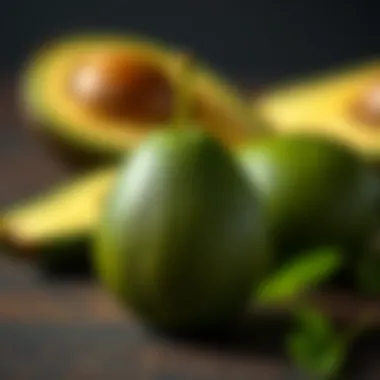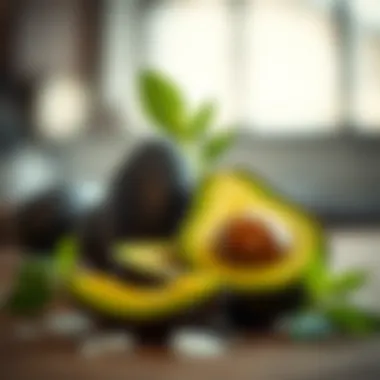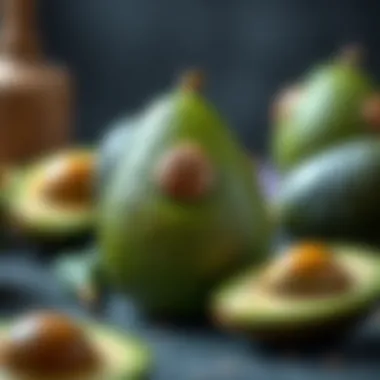Starting an Avocado Seed: An In-Depth Guide to Growth


Intro
The avocado, known scientifically as Persea americana, is not just a popular food choice due to its creamy texture and rich flavor; it also holds embedded wonders within its seed. For those willing to nurture this potential, starting an avocado seed can be both a rewarding and enlightening experience. In this guide, we will take a closer look at how to successfully germinate and cultivate an avocado plant, addressing everything from the initial preparations to potential obstacles you might encounter along the way.
Growing an avocado tree at home offers more than just the aesthetic appeal of a green plant. It opens the door to the satisfaction of watching your effort blossom into a fruit-bearing tree. Avocado seeds are brimming with nutrients, and understanding their science not only aids the germination process but also enhances the joy of tending to your green companion.
Let’s dive in, exploring the nitty-gritty aspects that will prepare you for a fruitful adventure in avocado cultivation.
Preface to Avocado Seeds
Starting your journey with avocado seeds opens up a world of possibilities beyond just enjoying the creamy flesh of the fruit. This phase is pivotal as it lays the groundwork for understanding how to nurture one of the most sought-after plants in gardens and kitchens. Avocados aren't just a passing trend; they're nutritional powerhouses packed with healthy fats, fiber, and various essential vitamins. By delving into the science of avocado seeds, you prep yourself to join a community passionate about sustainable gardening and healthy eating.
Understanding Avocado Reproduction
Avocado trees reproduce through seeds, and knowing this process gives us a deeper appreciation for what goes into every bite of the fruit. The journey starts when an avocado is pollinated, often relying on its own unique flowering pattern. This means that the tree can be both male and female, conveniently playing both roles to ensure fruitful yields. Cultivating avocados requires a little understanding of this mechanism, as it can impact the variety and quality of your future harvest.
In addition, be aware that not all avocado seeds are created equal. Some varieties like Hass produce fruit more reliably than others, which may take longer to bear fruit or struggle in certain climates. If you’re planning to grow your own avocado at home, consider the life cycle—from seed to sapling to tree. You’ll gain insight into the patience needed in cultivating this beloved crop, as it may take a while to see your seed transform into a flourishing plant.
Nutritional Profile of Avocados
When you bite into an avocado, you’re indulging in a blend of taste and nutrition. The nutritional profile of avocados is impressive, boasting a treasure trove of benefits that make them worthwhile to grow. They are low in sugar, provide a fair amount of fiber, and are rich in heart-healthy monounsaturated fats. This combination makes avocados a solid choice for maintaining a balanced diet.
Nutritional highlights include:
- Vitamins and Minerals: They contain copper, potassium, vitamin K, vitamin E, B vitamins, and folate.
- Healthy Fats: The monounsaturated fat contributes to reducing cholesterol and supporting heart health.
- Antioxidants: Avocados are loaded with antioxidants like lutein and zeaxanthin, which support eye health and may help reduce the risk of age-related vision issues.
Incorporating these nutritional gems into your daily meals could potentially drive you toward healthier eating habits. Cultivating avocados not only brings the satisfaction of growing your own food but also ensures you have these nutrients readily available at your fingertips.
"The avocado is a nutrient-dense fruit recommended by nutritionists and often praised in dietary plans for its numerous health benefits. Experience the joy of growing your own!"
In summary, starting with avocado seeds isn't just about planting; it's about fostering a connection with your food, understanding its background, and appreciating the nutrition it provides. Armed with this knowledge, you’re now ready to choose the right avocado for your gardening adventure.
Choosing the Right Avocado
Choosing the right avocado is a crucial step in the process of starting your own avocado plants. The flavor, texture, and even the ease with which the seed can germinate heavily depend on the quality and type of avocado you select. Realistically, not all avocados are created equally, and understanding what to look for can save you a world of heartache in your seed starting journey.
Selecting the Ideal Fruit
When selecting an avocado, there are a few things to keep in mind. Firstly, the ripeness of the fruit is paramount. A ripe avocado will yield to gentle pressure, indicating that it's ready for consumption but also assures you that the seed inside is perfectly mature for germination. If it’s too firm, the seed may not be as developed, while an overly soft avocado is likely past its prime, which may lead to an unproductive seed.
- Color Check: As they ripen, most avocado varieties change color. For instance, Hass avocados turn from green to a dark, purplish-black. Familiarizing yourself with the color changes of your chosen variety can help you evaluate ripeness accurately.
- Spot Inspection: Look for any blemishes or soft spots on the skin. It's best to avoid avocados with dark bruises, as they are indicative of mushiness and could affect the seed's viability.
- Weight Matters: A heavier avocado often means a juicier fruit, and a juicy fruit usually has a better-developed seed. So when picking from a pile, trust your instincts and go for the one that feels substantial in your hand.
Types of Avocado Varieties
Not all avocados are suitable for starting seeds; different varieties offer distinct traits. The most common types include the Hass, Bacon, and Fuerte avocados. Each variety comes with its benefits and flavors, thus influencing your choice for seed starting.
- Hass Avocado: Often hailed as the king of avocados, the Hass variety boasts a rich, creamy texture and a nutty flavor. Its rough skin changes color as it ripens, making it easy to assess its readiness. This type is frequently preferred for planting because it germinates reliably.
- Bacon Avocado: This variety has a smoother skin and is less oily compared to the Hass. It has a mild flavor and a slightly larger seed, which can also be a plus for aspiring growers looking for robust plants.
- Fuerte Avocado: Known for its pear shape and smooth skin, the Fuerte variety is a hybrid that can handle cooler temperatures better than many others. Its flavor is often described as a cross between the Hass and Bacon, making it a versatile choice.
Choosing the right avocado seed is akin to picking the right partner for a dance; both need to complement each other for a beautiful performance.
In summary, whether it’s for immediate enjoyment or the joy of growing your own trees, selecting the ideal avocado is a foundational step that shouldn’t be rushed. By paying close attention to factors like ripeness and variety, you're setting the stage for your own homegrown successes and might just find yourself with a thriving avocado tree in the years to come.
Preparing the Seed for Germination
Starting the process of growing an avocado seed begins with the preparation stage, which is crucial for setting the groundwork for a healthy and thriving plant. Proper preparation not only assists in germination but also significantly influences the eventual growth of the avocado tree. By understanding how to effectively clean and identify the seed's orientation, you can maximize the potential for successful sprouting.
Cleaning the Seed
Cleaning the avocado seed is an essential first step. It involves removing the fruit's flesh that might cling to the seed. Here’s why this step matters:
- Preventing Mold: Leftover fruit can lead to mold growth, which is detrimental to the seed's viability.
- Enhancing Germination: A clean seed has a better chance of absorbing moisture and nutrients.
To clean the seed, follow these steps:


- Rinse: Start by rinsing the seed under lukewarm water. Use your fingers to gently rub off any remaining avocado pulp.
- Soak: If necessary, soak the seed in water for about 10 minutes to help loosen stubborn bits of flesh.
- Dry: After cleaning, pat it dry with a paper towel. Take care not to damage the seed while drying.
"A clean seed is a happy seed," is how seasoned avocado growers often phrase it. Investing a little time in cleaning can have plentiful returns later on.
Identifying the Top and Bottom of the Seed
Knowing which end of the avocado seed is the top and which is the bottom plays a vital role in the germination process. The seed has a distinct orientation that must be recognized to ensure proper growth. Here’s how to identify each end:
- Top (rounded end): This part is usually slightly pointed and will eventually produce the stem and leaves.
- Bottom (flat end): The flat end is where the roots will emerge, making it critical that it is positioned correctly during planting.
To confirm which side is which, look for a small scar at the bottom of the seed; this is where it was attached to the fruit. Ensuring the seed is placed upright is crucial, as it influences how effectively it can take in water and nutrients necessary for growth.
In summary, starting with a clean seed and identifying its orientation can significantly impact the germination process and subsequent growth. Being mindful of these preparatory steps lays a solid foundation for nurturing a healthy avocado plant.
Methods to Start an Avocado Seed
Starting an avocado seed can feel like embarking on a little adventure in your own kitchen. It’s not just an experiment; it’s an invitation to nurture life from the ground up. Each method of germination has its nuances, which can influence the outcome in meaningful ways. By exploring both the water and soil methods, you can find the one that resonates best with your style of gardening. Not only do these methods connect you with nature, but they also offer practical benefits such as enhanced growth rates and even a deeper understanding of the avocado plant itself.
Let’s delve into these methods and discover how they pave the way for your future avocado plants.
Water Method
The water method is favored by many, particularly beginners, for its simplicity and visual appeal. Watching the roots gradually sprout from the seed can be quite enchanting. This transparent setup makes it easy to monitor progress, ensuring that your avocado’s journey is in full view.
Supplies Needed
To get rolling with the water method, you’ll need a few essential supplies:
- A ripe avocado seed
- Toothpicks
- A glass or jar that can hold enough water to submerge the bottom half of the seed
The unique aspect here lies in the toothpicks. They act as supports, propping up the seed while keeping it partially submerged in the water. This method works well because it allows oxygen to reach the seed, creating an environment conducive to germination. The visual aspect is also a huge plus – you can literally see the roots unfurling, which can be pretty satisfying.
Step-by-Step Instructions
- Carefully clean the avocado seed, removing any leftover pulp.
- Identify the broader end of the seed, which is where the roots will emerge.
- Insert three toothpicks into the seed at an angle.
- Place the seed in the jar, ensuring the wider end is in the water.
- Keep the jar in a warm, sunny spot, and change the water every few days.
This method’s charm lies in its straightforward nature, making it nearly foolproof. Just be patient, and give your seed the time to sprout roots and stems. However, it can sometimes take longer for the seed to germinate compared to the soil method, which is a consideration to keep in mind.
Expected Timeline
The timeline for the water method can be quite variable. Generally, expect to see roots forming within 2 to 6 weeks. Be patient! The seed will also begin to sprout a stem sometime after the roots are established. Depending on conditions like temperature and light exposure, the growth can either be swift or a bit sluggish. It’s all part of the avocado’s charm.
Soil Method
The soil method often appeals to those who feel ready to get their hands dirty and want to encourage a more accelerated growth process. This approach mimics the natural environment and may yield quicker results regarding root and shoot development.
Choosing the Right Soil
For this method to work well, selecting the right soil is key. You’ll want a well-aerated, nutrient-rich potting mix that allows for good drainage. Mixing in perlite or peat moss can further enhance this structure.
Good soil serves as a foundation, quite literally. It not only provides nutrients to facilitate growth but also retains adequate moisture while preventing rot. Using the right mix sets the stage for healthy growth and successful transplantation down the line.
Planting Technique
To plant your avocado seed in soil:
- Fill a pot with the prepared potting mix.
- Plant the seed, leaving the top half exposed.
- Firmly but gently pack the soil around it to eliminate air pockets.
- Water thoroughly and place in a warm, well-lit area.
The soil method allows the seed to establish itself in a more natural setting. However, it does require a bit more vigilance in terms of watering and monitoring moisture levels as compared to the water method.
Moisture Levels
Maintaining the right moisture levels is crucial in this method. Overwatering can quickly lead to rot, while underwatering may stunt growth. Water the soil lightly when the top inch feels dry, ensuring drainage to prevent pooling. This balance is vital for nurturing a thriving seedling.
Effective moisture management can make or break your seed’s chance of thriving, so keep a careful eye on conditions. Although it requires a bit more work than the water method, the rewarding feeling of digging into soil and watching a plant grow can be immensely fulfilling.


Through either the water or soil method, starting your avocado seed can be a rich experience, one that brings the joys of nurturing a plant into the comfort of your space. As you explore these approaches, the subtle differences in care and attention become evident, and soon enough, you’ll find your way to your own homegrown avocados.
Care for Growing Avocado Seedlings
Taking care of growing avocado seedlings is essential for their development into healthy, robust plants. Once you’ve successfully germinated the seed and nurtured it into a young tree, the real work begins. Providing the right conditions during this stage can mean the difference between a thriving avocado plant and one that struggles to survive.
Several factors play a crucial role in the care of these seedlings, most notably light, water, and nutrition. Understanding these elements will help you create an ideal environment for your avocado plant, paving the way for a future bounty of delicious avocados.
Light Requirements
Avocado plants are sunlight-loving beings. To really flourish, they require bright, indirect sunlight. A south-facing window is often the best spot. You want to avoid placing them in direct sunlight for long periods, as that can scorch their leaves.
Here are some practical tips for light management:
- Monitor the Sun: If you see the leaves turning yellow or brown, that may signal too much sun.
- Rotate your Plant: Turn your avocado seedling every week to ensure even growth and prevent it from leaning toward the light.
In cases where natural light is insufficient, consider using grow lights to supplement. These can provide a more controlled lighting schedule and consistency in growth, especially during the shorter days of winter.
Watering Guidelines
Watering is a delicate balance. You want to keep the soil moist but not soggy. Letting the roots sit drenched in water can cause rot, which can be fatal to your seedling.
A good practice is to stick your finger about an inch into the soil:
- If the soil feels dry, it’s time to water.
- If it’s still damp, hold off for a day or two.
Additionally, the pot you choose should have proper drainage holes. This allows excess water to escape, preventing root issues. On warmer days, your avocado might need a bit more water due to evaporation, while cooler days might require less. Paying attention to this can help in ensuring that your seedling stays healthy.
Fertilization Needs
Nutrition is the fuel for growth. While young avocado seedlings don’t need fertilizer immediately, once they’ve established a few leaves, you can begin to feed them.
- Use Balanced Fertilizers: Look for a balanced fertilizer formulated for young plants. Something like a 10-10-10 or a diluted fish emulsion can do wonders.
- Apply Sparingly: Too much fertilizer can burn the roots, leading to stress on the plant.
Feeding typically starts around 6 to 8 weeks after germination. You can fertilize every four to six weeks during the growing season. Always dilute according to instructions, as young plants are sensitive and need a mild dose.
In summary, keeping an eye on light, water, and fertilizer will provide your avocado seedlings a fighting chance for a healthy life. With the right care, they will reward your efforts with splendid growth and possibly, in a few years, avocados aplenty.
"The road to a fruitful avocado starts with nurturing its beginnings."
For further reading on plant care specifics, visit University of Florida and Cornell University for research-backed information.
Transplanting Avocado Seedlings
Transplanting avocado seedlings is a crucial phase in the growth journey of your avocado plant. It's not merely about moving the plant from one pot to another; it's about offering your budding avocado tree the right environment to thrive. A successful tranplant can dramatically influence the plant's growth, resilience, and overall fruiting potential. This process allows seedlings to transition from a protected indoor setting into a more permanent outdoor home, where they can draw upon natural sunlight, air circulation, and nutrient-rich soil.
When to Transplant
Timing plays an essential role in the success of transplanting. Generally, avocado seedlings should be transplanted when they are around 6 to 8 inches tall and have developed a few mature leaves. This growth stage indicates that the plant has strong enough roots to support itself in a more extensive and potentially more challenging environment.
Here are some key indicators to consider:
- Root Development: Check if the roots are beginning to circle the bottom of the pot. If they do, that’s a good sign it’s time to move.
- Leaf Count: Aim for at least three to four sets of true leaves. More leaves often mean a stronger plant ready for its next home.
- Weather Conditions: Wait for warm weather, typically when the threat of frost has passed. Ideal temperatures stay consistent above 50°F (10°C).
Transplanting at the right moment can significantly affect both the health of the plant and its future yield, as well-timed transplantation sets the stage for vigorous growth.
Transplanting Process
The actual process of transplanting involves careful handling of the seedling and thoughtful preparation of the new planting area. Here's how to make sure it goes smoothly:
- Prepare the New Site: Select a well-draining spot in your garden or a large pot filled with potting soil, preferably containing organic matter and nutrients. A mix rich in hummus can work wonders.
- Water the Seedling: A day before transplanting, water your seedling thoroughly. This helps soften the soil and makes it easier to remove without damaging the roots.
- Gently Remove the Seedling: Hold the base of the stem and carefully slide your fingers around the soil to lift the plant out. Avoid pulling on the stem itself, as this could break it.
- Inspect the Roots: Once out, check the roots for any signs of rot or damage. Healthy roots should be white or light tan and free of mushy spots.
- Transplant: Dig a hole in the prepared site that’s about twice the width of the root ball and as deep as the roots. Place the seedling in the hole, filling it with soil. Ensure the top of the root ball is level with the surrounding soil. Firmly pack the soil around the base but avoid compacting it too much, as this can restrict airflow.
- Water After Transplanting: Immediately after transplanting, give the seedling a good drink of water to settle the soil and help alleviate any stress from the move.
- Tip: If you choose to plant outdoors, ensure the location receives ample sunlight (at least 6 hours daily).
"Proper transplanting not only supports growth but also prepares your seedling to become a fruitful avocado tree."


- Post-Transplant Care: For the first few weeks, keep an eye on the moisture levels. New transplants can be a bit fussy, so a consistent moisture level is key. Avoid direct harsh sunlight for the first few days until the plant adjusts.
By following these steps, your avocado seedlings can smoothly transition into robust young trees, setting the foundation for a bountiful harvest in the future.
Common Challenges in Growing Avocados
Growing avocados can be a rewarding venture, but like any gardening endeavor, it comes with its fair share of challenges. Understanding these hurdles is crucial for anyone passionate about nurturing these unique plants. This section focuses on the typical roadblocks that avocado growers may face, including pests, diseases, and environmental stressors. Grasping these challenges helps set realistic expectations and fosters better care practices for your avocado trees.
Pests and Diseases
When growing avocados, keeping an eye out for pests is like being a detective. Avocado trees can fall victim to a few notorious pests that threaten their health. The most common culprits include spider mites, aphids, and the avocado lace bug. These pests usually suck the sap from the plant, weakening it over time.
- Spider Mites: Tiny and often invisible to the naked eye, these creatures live on the underside of leaves, causing yellowing and eventual leaf drop.
- Aphids: These bugs can form colonies and their presence equals sticky residue and black soot caused by sooty mold, which covers leaves and blocks sunlight.
- Avocado Lace Bug: Known for causing silver stippling on leaves, this bug can really put a damper on the growth.
In addition to pests, diseases can also spring up unexpectedly. Notable diseases that can harm avocados are root rot and downy mildew. Root rot is often caused by overwatering, leading to soggy soil and starving roots. Downy mildew, on the other hand, thrives in humid conditions and can turn the leaves into a veritable patchwork of brown spots.
Addressing these issues requires vigilance. Regularly inspecting your plants can help catch infestations early. Using organic insecticidal soap or neem oil can help manage pests. For root rot, ensuring proper drainage and not overwatering are key preventive measures. Knowing the signs of plant diseases and reacting promptly can save your avocado trees from potential collapse.
Environmental Stress Factors
Weather conditions can be a double-edged sword for any gardening endeavor, and avocado cultivation is no different. One of the biggest environmental stress factors is temperature. Avocado trees thrive in warm climates but are particularly sensitive to extremes. Frost can be catastrophic, leading to serious damage. Growers in cooler areas should consider planting varieties like the Bacon Avocado, which is more tolerant to chill.
- Humidity: Avocados also prefer a moderate to high humidity level. Dry conditions can cause problems like leaf drop and stunted growth. Implementing misting systems or grouping plants together can create a more humid microclimate.
- Water Quality: Avocados are sensitive to salt. If you use tap water that is high in salts or bicarbonates, it might harm your .growing trees. Rainwater or distilled water can provide relief in such situations.
- Soil Quality: Well-draining soil is essential. Heavy and compacted soils can lead to root problems. Amending your soil with organic materials helps improve drainage and nutrient content.
Environmental factors often interact with one another—high humidity with excessive heat can be particularly taxing on young plants. Keep track of local conditions and be prepared to adapt. Regularly monitoring your plants and adjusting care strategies can mitigate these challenges.
Remember, even seasoned gardeners encounter hurdles. Every challenge is a learning opportunity that enhances your skills and ultimately, leads you closer to flourishing avocado trees.
Through understanding pests, diseases, and environmental intricacies, avocado enthusiasts can truly elevate their gardening game, ensuring healthier plants and a more fruitful yield.
Benefits of Growing Avocado Plants
Growing avocado plants at home can be more than just a gardening hobby; it’s a flurry of benefits that can sprinkle joy into your daily life. These plants do not merely serve a purpose; they embody a fusion of health, aesthetics, and sustainability, cultivating both mind and body.
Homegrown Avocados
Freshness and Flavor
When you grow your own avocados, the difference in taste is like night and day compared to store-bought ones. The moment you slice open a ripe avocado from your garden, you’ll understand what real freshness is. Their creamy texture and rich flavor can enhance any dish—be it a morning toast, a salad, or a taco. As they say, ‘you can’t buy happiness, but you can grow avocados!’
Moreover, homegrown avocados hit all the right notes when it comes to nutritional goodness. They’re packed with heart-healthy fats, fiber, and essential vitamins. When you have your own avocado tree, each harvest is not just a yield; it’s a nourishing experience that guarantees quality and satisfaction.
Cost-Effectiveness
Let’s be soberer for a moment—avocados can be pricey in the supermarket. With a modest initial investment in seeds or small plants, along with regular care, homegrown avocados can bring you both quantity and quality without breaking the bank. Plus, there’s joy in harvesting your own food—a connection to the seed you nurtured, turning it into something delicious.
Aesthetic Value in Landscaping
Beautifying Your Space
Avocado trees are not just functional; they offer an elegance that can transform any backyard or garden space. With their lush green leaves and potential for lovely fruits, they can be a visual delight year-round. Imagine stunning foliage in the summer, which also becomes a vibrant, playful habitat for various birds and insects. It’s like adding a touch of paradise right in your backyard.
Shade and Environment
Moreover, avocado trees can provide ample shade. As they grow, they serve as living umbrellas, offering respite from the sun's glaring rays. They can contribute to lowering the temperature around your home, reducing the need for artificial cooling—talk about eco-friendliness! Planting such trees can also lead to improved air quality by absorbing carbon dioxide and releasing oxygen, making your home a little greener in more ways than one.
As the saying goes, ‘big trees grow from small seeds.’ The act of nurturing an avocado plant encapsulates a holistic approach to living—nurturing the environment, enhancing your surroundings, and feeding your belly, all of which cultivate a mindful existence. If you’re sitting on the fence about starting your avocado journey, consider these benefits that go hand in hand with growing your own avocado plants. It’s a rewarding experience that resonates on many levels.
End
Wrapping our heads around the journey from a humble avocado seed to a thriving plant certainly holds its weight in importance. This guide has covered the essentials of starting an avocado seed, aiming to empower you with the know-how to not just grow a tree, but also to appreciate the process that unfolds with each step. The knowledge you've gained about germination methods, care strategies, and the overall benefits of an avocado plant isn't just useful; it enhances your connection to the food you consume.
By understanding the key steps involved in this endeavour, you can steer clear of potential pitfalls that come hand in hand with growing avocados. In addition, knowing what environmental conditions are necessary will help you create the best possible growing environment for your seedlings.
In summary, approaching avocado cultivation is about more than just sowing a seed; it's about integrating some joy and mindfulness into your gardening routine.
Summary of Key Steps
- Choosing the right avocado is your first task. Picking a ripe, healthy fruit makes a world of difference in the germination process.
- Preparing the seed for sprouting involves cleaning and correctly identifying its top and bottom. A little care goes a long way.
- Opting for a germination method—whether it’s the water method or the soil method—depends on your personal preference and circumstances.
- Caring for your avocado seedling includes managing light exposure, watering schedules, and nutrition to ensure it grows healthy and strong.
- When the time is right, transplanting your seedlings into larger spaces paves the way for growth as they mature.
- Throughout the entire process, being aware of common challenges will prepare you for any setbacks.
With these steps in mind, you’re armed with a concise roadmap for success.
Final Thoughts on Avocado Cultivation
Furthermore, consider embracing the ups and downs of this process as part of the learning experience. After all, growing plants fosters both resilience and a greater appreciation for nature’s cycles. Your commitment to nurturing an avocado plant reflects a larger desire to engage with one of the most celebrated fruits on the planet; it’s a journey that connects you to sustainability, health, and culinary delight.
Should you wish to delve deeper into various aspects of avocado care and cultivation, you may find these resources informative:
Each link offers further insight into how to expand your knowledge and perhaps inspire you to share your own journey with fellow plant enthusiasts.







